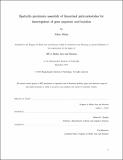Spatially-proximate assembly of linearized polynucleotides for interrogation of gene sequence and location
Author(s)
Obidin, Nikita.
Download1227787691-MIT.pdf (9.878Mb)
Other Contributors
Program in Media Arts and Sciences (Massachusetts Institute of Technology)
Advisor
Edward S. Boyden.
Terms of use
Metadata
Show full item recordAbstract
In traditional methods of gene interrogation, polynucleotide fragments are deposited onto flow cells for sequencing, fixed and labeled in-situ, or run through an electrophoresis gel to determine location, structure, or function. Though significant improvements have been made in resolving the genome, highly repetitive regions remain impossible to assemble at the limited resolution of optical labeling techniques and insufficient read-lengths of current sequencing technologies. In this work, I investigate methods for sequence labeling and identification made possible through megabase-scale assembly of polynucleotide fragments. I demonstrate the viability of linearizing long mammalian DNA fragments through nucleotide anchoring, acrylate polymerization, isotropic fragmentation, and expansion. I then elucidate gene structure through post-expansion in-situ hybridization labeling and enzymatic strand extension. Furthermore, I demonstrate the applicability of the process to a target of clinical interest, namely the facio-scapulo-humeral muscular dystrophy associated D4Z4 gene. Finally, I demonstrate a theoretical approach for sequencing of the native DNA with the eventual goal of a complete human genome assembly.
Description
Thesis: S.M., Massachusetts Institute of Technology, School of Architecture and Planning, Program in Media Arts and Sciences, September, 2020 Cataloged from student-submitted PDF version of thesis. Includes bibliographical references (pages 26-28).
Date issued
2020Department
Program in Media Arts and Sciences (Massachusetts Institute of Technology)Publisher
Massachusetts Institute of Technology
Keywords
Program in Media Arts and Sciences